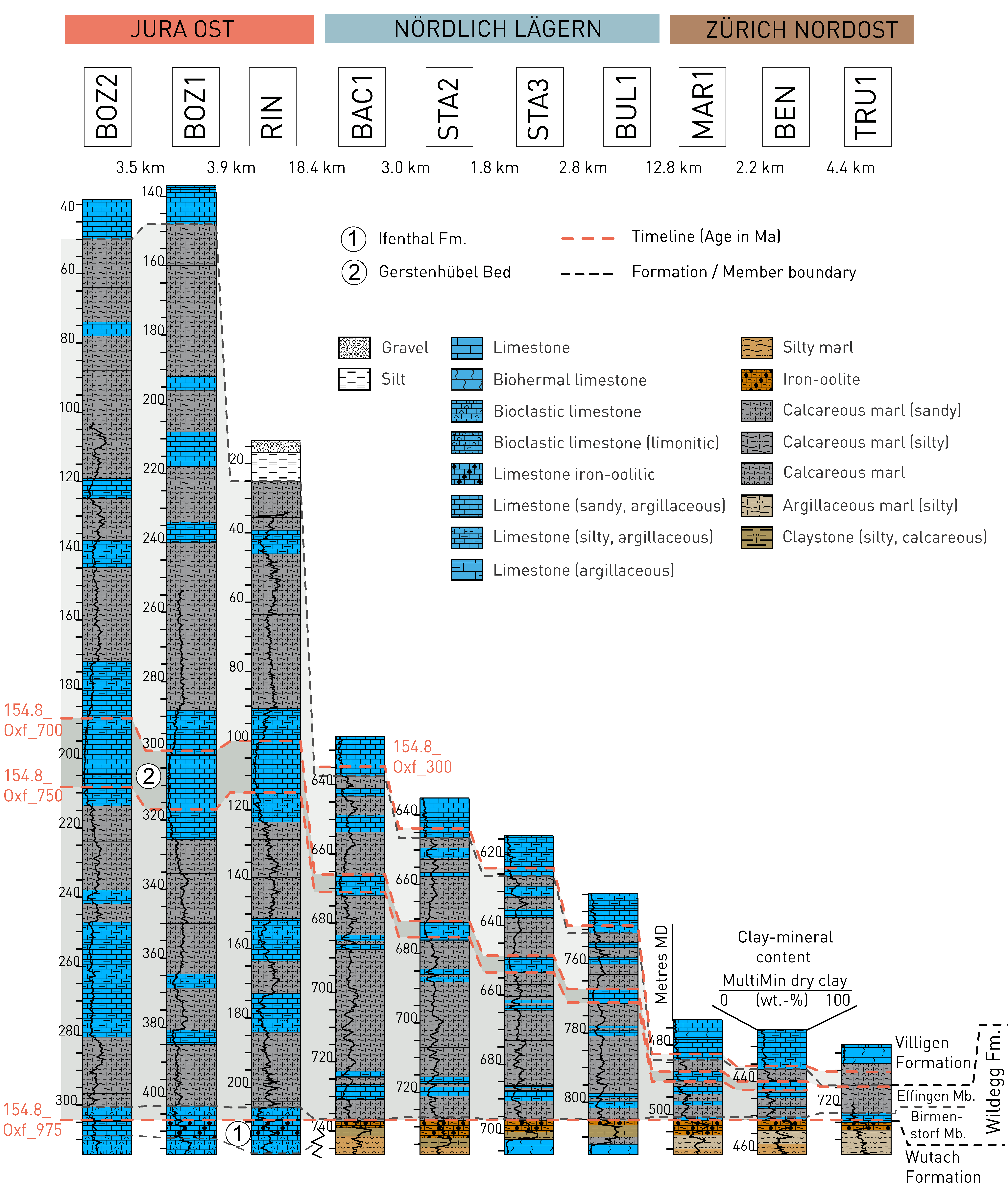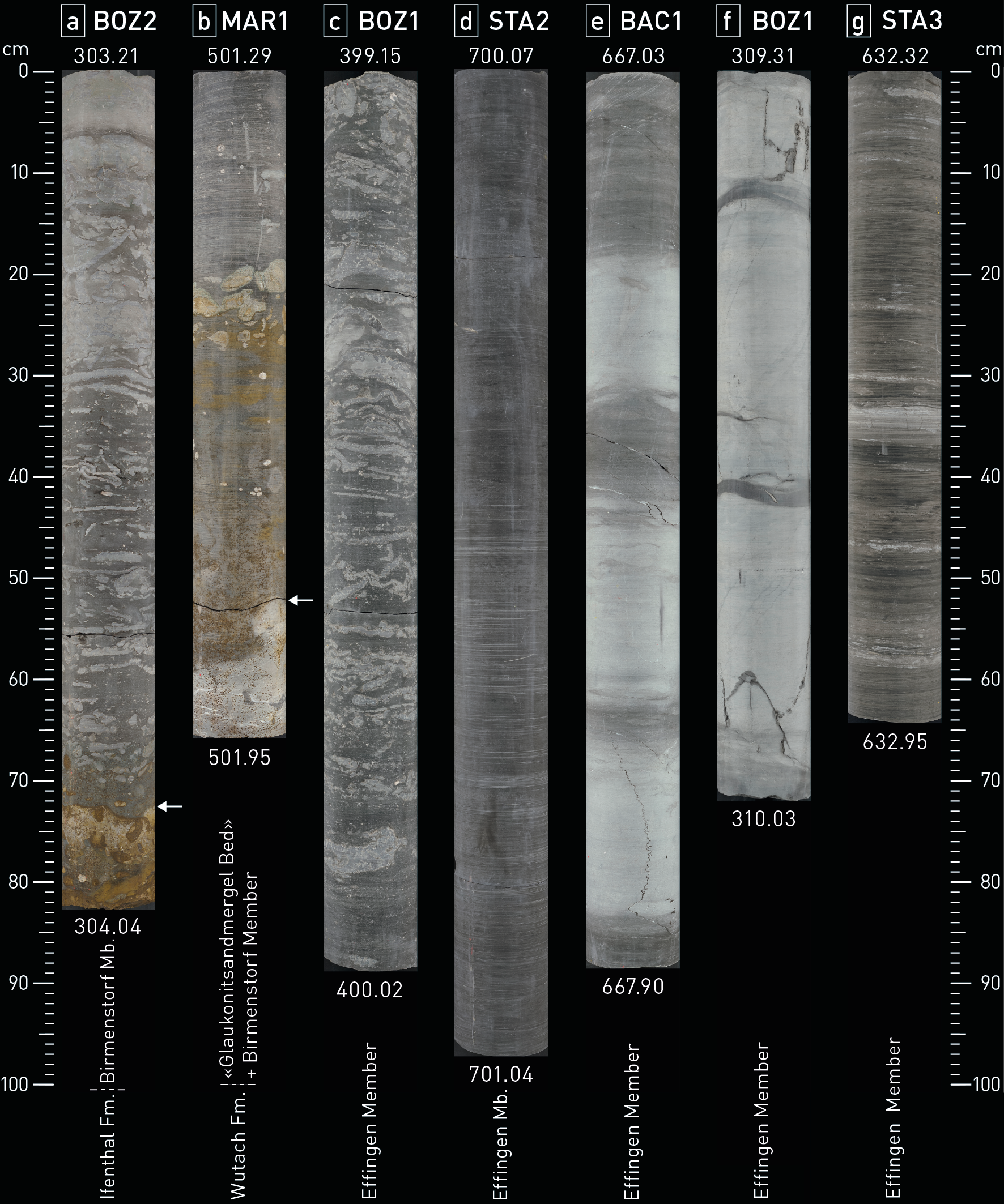The Wildegg Formation was deposited in a shallow epicontinental sea in the carbonate-siliciclastic Swabian facies realm, with a depositional centre that corresponds to the present-day area between Olten, Aarau and Brugg (Chapter 3). Mass wasting deposits, especially in the lower Effingen Member, indicate relief contrasts in the basin. Towards the west, the Effingen Member was bounded by the eastern part of the Celtic Platform consisting of a carbonate shoal with oolites and coral bioherms (Günsberg Formation) and a backreef environment with a lagoonal facies (Vellerat Formation; Gygi 2000a, Strasser et al. 2012). The patch-reef belt migrated south-eastwards towards the basin during the Oxfordian (Gygi 1986). To the south, the shelf sea merged into the open Piemont – Liguria Ocean. The nearest mainlands were the London-Brabant, Rhenish and Bohemian Massifs in the north and east. During the first phase of the deposition of the Wildegg Formation, sedimentation rates were low to very low, particularly in the eastern Birmenstorf Member. In contrast, during the deposition of the Effingen Member sedimentation rates were very high within the depositional centre between Olten, Aarau and Brugg, although with an eastward-decreasing trend (Fig. 4‑4, Fig. 4‑5, Fig. 4‑6). During the Late Jurassic, accommodation space was created by subsidence as the compacted sedimentary rock thickness exceeded the estimated water depth of ca. 50 – 100 m. The development of the depositional centre can be explained by differential subsidence (Allenbach 2001, 2002). The sediment accumulation pattern may also have been characterised by reworking by bottom current systems, perhaps along the eastern side of the carbonate platform (sediment drift deposits). The partly correlatable limestone and calcareous marl successions might reflect climate cycles in combination with relative sea level changes (Allenbach 2001, Deplazes et al. 2013). The depositional evolution of the Wildegg Formation is subdivided here into three time intervals (Fig. 4‑48):
The first time interval (154.8_Oxf_975 to 154.8 Oxf_750) approximately corresponds to the Birmenstorf Member and the Effingen Member below the Gerstenhübel Bed. This time interval starts with a phase of condensation especially in the east, where only a succession of hardgrounds is preserved. In the west, a somewhat thicker succession with sponge bioherms was deposited. The Effingen Member below the Gerstenhübel Bed is mainly interpreted as a deposition formed during relatively low sea-level conditions (Gygi et al. 1998, Allenbach 2001). In this setting, more siliciclastic sediment must have reached the basin that led to an overall increase in the deposition of siliciclastics. At the same time, the area of carbonate production in the shelf environment decreased, leading to a lower calcareous input.
The second time interval (154.8_Oxf_750 to 154.8 Oxf_700) approximately corresponds to the deposition of the Gerstenhübel Bed. It was possibly deposited during relatively high sea-level conditions. With a higher sea level, more siliciclastic material was trapped in the flooded coastal plains and the transport distances of the siliciclastics to the shallow basin increased. On the platform, carbonate production may have increased as accommodation space increased, and as the siliciclastic input may have decreased (less turbidity); at the same the increased calcareous production may have caused an increased calcareous export into the shallow basin.
The third time interval (154.8_Oxf_700 to 154.8 Oxf_300) approximately corresponds to the Effingen Member above the Gerstenhübel Bed. It may correspond to a second phase of deposition during relatively low sea-level conditions that was followed by a second phase of deposition during relatively high sea-level conditions, which is reflected by the uppermost Effingen Member and the overlying Villigen Formation. The top of the Effingen Member is probably diachronous. In the east the mostly carbonate-dominated sedimentation of the Villigen Formation started slightly earlier, whereas in the west the mixed siliciclastic-carbonate facies lasted longer.

Fig. 4‑48:Stratigraphic borehole correlation of the Wildegg Formation
For lithological nomenclature refer to Naef et al. (2019). Clay-mineral content after Becker & Marnat (2024) Some of the boundaries and lithologies as discussed in the original reports were adjusted to integrate all presented borehole data.

Fig. 4‑49:Selected core photos of the Wildegg Formation
(a) Reddish brown iron-oolite (hardground) below glauconitic, bioclastic argillaceous to calcareous marl and limestone with many light grey sponges; (b) Reddish grey iron-oolitic limestone (hardground) below grey glauconitic argillaceous marl with reworked iron-ooids in the lower part and oncolitic limestone bed; (c) dark grey bioclastic, glauconitic, argillaceous marl with many light grey sponges; (d) dark grey calcareous marl; (e) & (f) intercalation of light grey limestone with cm- to dm-scale beds of calcareous marl; (g) dark grey argillaceous marl, silty with centimetre-scale limestone layers.

